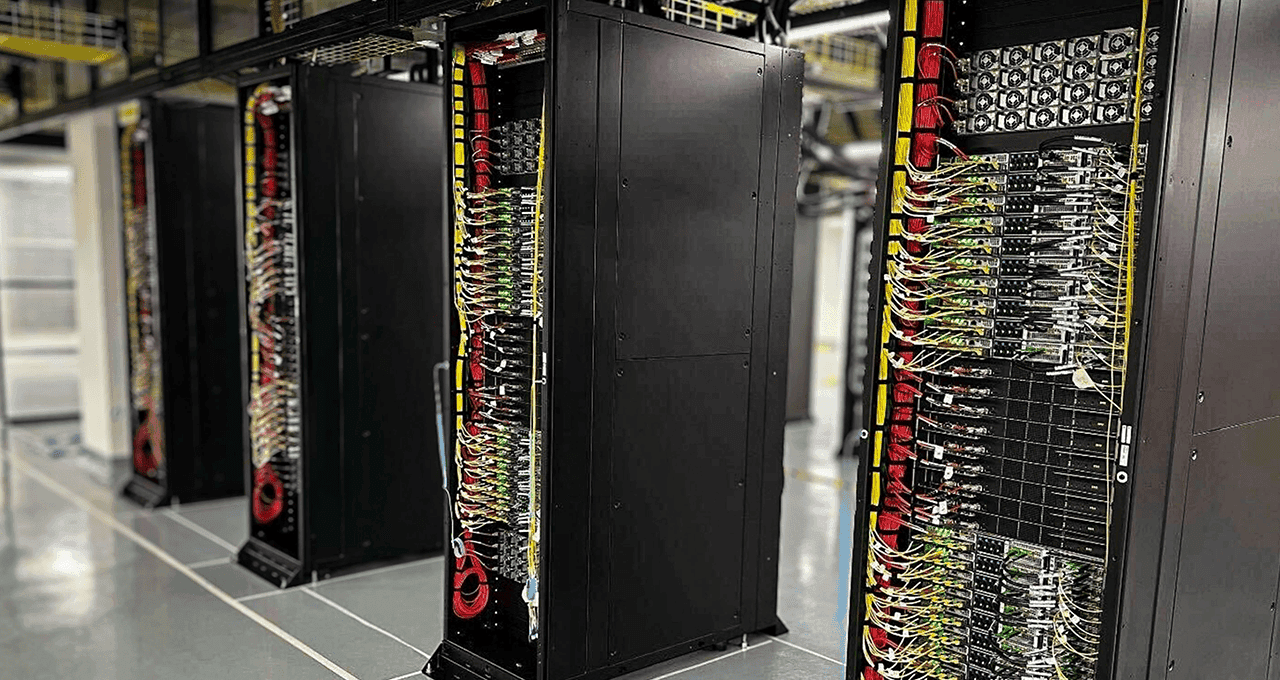Oracle and AMD Collaborate to Boost AI Performance with New GPU Offering
2 Sources
2 Sources
[1]
Oracle to deploy AMD Instinct MI355X GPUs in cloud for AI workloads By Investing.com
AUSTIN, Texas and SANTA CLARA, Calif. - Oracle (NYSE: ORCL), a $559 billion market cap technology giant with a GOOD financial health rating according to InvestingPro, announced Thursday it will add AMD Instinct MI355X GPUs to its cloud infrastructure offerings, providing customers with additional options for AI computing resources. According to a press release, Oracle Cloud Infrastructure (OCI) will deploy zettascale AI clusters with up to 131,072 MI355X GPUs, aimed at supporting large-scale AI training and inference workloads. This expansion aligns with Oracle's strong revenue growth of 6.23% over the last twelve months, with total revenue reaching $55.78 billion. The new GPU offering is designed to deliver more than twice the price-performance compared to previous generations, featuring 288 gigabytes of high-bandwidth memory and up to eight terabytes per second of memory bandwidth. "AMD Instinct GPUs, paired with OCI's performance, advanced networking, flexibility, security, and scale, will help our customers meet their inference and training needs for AI workloads and new agentic applications," said Mahesh Thiagarajan, executive vice president at Oracle Cloud Infrastructure. The AMD Instinct MI355X GPUs will be deployed in a liquid-cooled design that supports 125 kilowatts per rack with 64 GPUs per rack. Oracle states this configuration enables faster training times with higher throughput and lower latency. Oracle will also be the first to deploy AMD Pollara AI NICs on backend networks, providing advanced networking capabilities for AI workloads. The new offering includes support for the 4-bit floating point compute standard, which Oracle claims enables more cost-effective deployment of large language and generative AI models. Oracle (NYSE: ORCL) and AMD's collaboration continues their partnership in providing cloud computing solutions. The companies did not disclose pricing or specific availability dates for the new GPU offerings. In other recent news, Oracle reported impressive fiscal fourth-quarter results, with revenue and earnings per share exceeding expectations. The company has raised its fiscal year 2026 revenue guidance to over $67 billion, reflecting a 16% year-over-year growth in constant currency. Oracle Cloud Infrastructure (OCI) demonstrated significant growth, with a 62% increase in the fourth quarter and projections to exceed 70% growth in fiscal year 2026. The company's remaining performance obligations (RPO) are also expected to grow more than 100% in the same period. Several financial firms have responded positively to Oracle's performance and future outlook. BNP Paribas Exane raised its price target to $226, citing strong growth prospects across Oracle's key business segments. UBS increased its target to $225, highlighting Oracle's extraordinary backlog growth. Cantor Fitzgerald and Stifel also adjusted their targets to $216 and $180, respectively, emphasizing the company's robust Infrastructure as a Service (IaaS) growth projections. However, some analysts have expressed concerns about potential margin erosion and the need for increased capital expenditures to support growth. Despite these concerns, the overall sentiment remains positive, with many firms maintaining favorable ratings on Oracle's stock. The company's participation in projects like Stargate further underscores its position as a leader in AI cloud infrastructure.
[2]
Oracle and AMD Collaborate to Help Customers Deliver Breakthrough Performance for Large-Scale Ai and Agentic Workloads
Oracle and AMD announced that AMD Instinct?? MI355X GPUs will be available on Oracle Cloud Infrastructure (OCI) to give customers more choice and more than 2X better price-performance for large-scale AI training and inference workloads compared to the previous generation. Oracle will offer zettascale AI clusters accelerated by the latest AMD Instinct processors with up to 131,072 MI355X GPUs to enable customers to build, train, and inference AI at scale. To support new AI applications that require larger and more complex datasets, customers need AI compute solutions that are specifically designed for large-scale AI training. The zettascale OCI Supercluster with AMD Instinct MI355X GPUs meets this need by providing a high-throughput, ultra-low latency RDMA cluster network architecture for up to 131,072MI355X GPUs. AMD Instinct MI355X delivers nearly triple the compute power and a 50% increase in high-bandwidth memory than the previous generation. AMD Instinct MI355 X-powered shapes are designed with superior value, cloud flexibility, and open-source compatibility--ideal for customers running today's largest language models and AI workloads. With AMD Instinct MI355X on OCI, customers will be able to benefit from: Significant performance boost: Helps customers increase performance for AI deployments with up to 2.8X higher throughput. To enable AI innovation at scale, customers can expect faster results, lower latency, and the ability to run larger AI workloads. Larger, faster memory: Allows customers to execute large models entirely in memory, enhancing inference and training speeds for models that require high memory bandwidth. The new shapes offer 288 gigabytes of high-bandwidth memory 3 (HBM3) and up to eight terabytes per second of memory bandwidth. New FP4 support: Allows customers to deploy modern large language and generative AI models cost-effectively with the support of the new 4-bit floating point compute (FP4) standard. This enables ultra-efficient and high-speed inference. Dense, liquid-cooled design: Enables customers to maximize performance density at 125 kilowatts per rack for demanding AI workloads. With 64 GPUs per rack at 1,400 watts each, customers can expect faster training times with higher throughput and lower latency. Built for production-scale training and inference: Supports customers deploying new agentic applications with a faster time-to-first token (TTFT) and high tokens-per-second throughput. Customers can expect improved price performance for both training and inference workloads. Powerful head node: Assists customers in optimizing their GPU performance by enabling efficient job orchestration and data processing with an AMD Turin high-frequency CPU with up to three terabytes of system memory. Open-source stack: Enables customers to leverage flexible architectures and easily migrate their existing code with no vendor lock-in through AMD ROCm. AMD ROCm is an open software stack that includes popular programming models, tools, comp and data processing and inference.
Share
Share
Copy Link
Oracle partners with AMD to deploy Instinct MI355X GPUs in its cloud infrastructure, aiming to provide superior AI computing resources for customers.
Oracle and AMD Join Forces for Advanced AI Cloud Infrastructure
Oracle, the $559 billion market cap technology giant, has announced a significant expansion of its cloud infrastructure offerings in collaboration with AMD. The partnership aims to deploy AMD Instinct MI355X GPUs in Oracle Cloud Infrastructure (OCI), providing customers with enhanced options for AI computing resources
1
.Zettascale AI Clusters and Performance Boost
Oracle plans to offer zettascale AI clusters accelerated by the latest AMD Instinct processors, supporting up to 131,072 MI355X GPUs. This massive scale is designed to enable customers to build, train, and run inference on AI models at an unprecedented scale. The new GPU offering is engineered to deliver more than twice the price-performance compared to previous generations, featuring 288 gigabytes of high-bandwidth memory and up to eight terabytes per second of memory bandwidth
2
.Advanced Features and Design
The AMD Instinct MI355X GPUs will be deployed in a liquid-cooled design that supports 125 kilowatts per rack with 64 GPUs per rack. This configuration enables faster training times with higher throughput and lower latency. Oracle will also be the first to deploy AMD Pollara AI NICs on backend networks, providing advanced networking capabilities for AI workloads
1
.Support for New AI Standards
The new offering includes support for the 4-bit floating point compute standard, which Oracle claims enables more cost-effective deployment of large language and generative AI models. This feature allows customers to deploy modern large language and generative AI models efficiently with ultra-efficient and high-speed inference
2
.Oracle's Growth and Financial Performance
This expansion aligns with Oracle's strong revenue growth of 6.23% over the last twelve months, with total revenue reaching $55.78 billion. The company recently reported impressive fiscal fourth-quarter results, exceeding expectations for revenue and earnings per share. Oracle has raised its fiscal year 2026 revenue guidance to over $67 billion, reflecting a 16% year-over-year growth in constant currency
1
.Related Stories
Analyst Reactions and Future Outlook
Several financial firms have responded positively to Oracle's performance and future outlook. BNP Paribas Exane raised its price target to $226, citing strong growth prospects across Oracle's key business segments. UBS increased its target to $225, highlighting Oracle's extraordinary backlog growth. However, some analysts have expressed concerns about potential margin erosion and the need for increased capital expenditures to support growth
1
.Implications for AI Innovation
This collaboration between Oracle and AMD represents a significant step forward in providing cloud computing solutions for AI workloads. The enhanced performance and scale offered by the new GPU infrastructure are expected to accelerate AI innovation across various industries, enabling customers to tackle more complex and larger AI models with improved efficiency and cost-effectiveness
2
.References
Summarized by
Navi
[1]
Related Stories
Recent Highlights
1
Google launches Gemini 3 Flash as default AI model, delivering speed with Pro-grade reasoning
Technology

2
OpenAI launches GPT Image 1.5 as AI image generator war with Google intensifies
Technology

3
OpenAI launches ChatGPT app store, opening doors for third-party developers to build AI-powered apps
Technology








